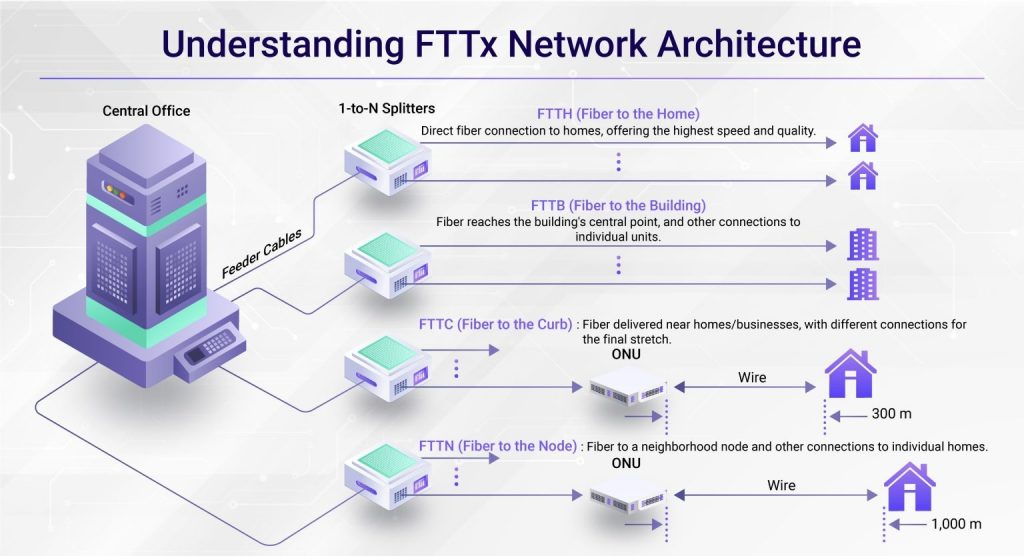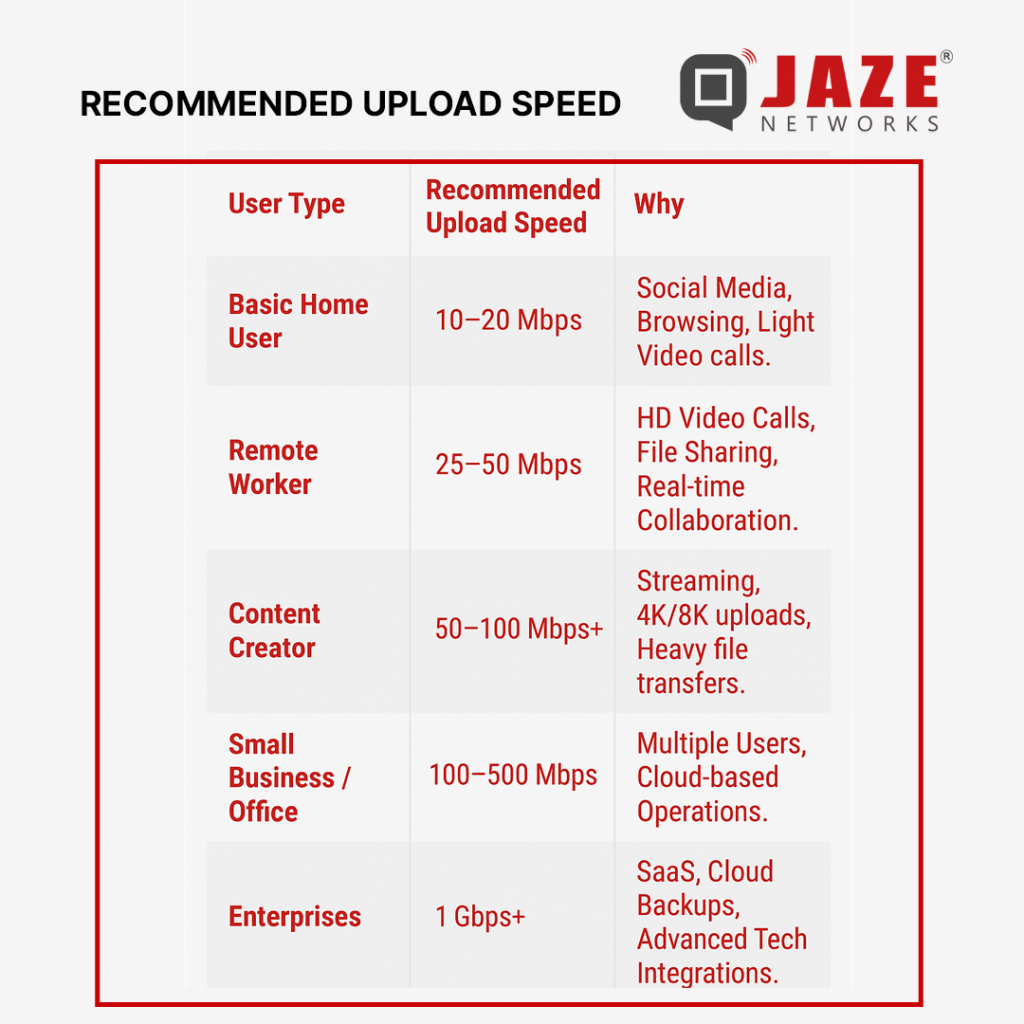




Fiber to the X (FTTX) is more than just a buzzword; it represents a fundamental shift in how we connect to the digital world. It is the general term for any broadband network architecture that replaces all or part of the traditional metal local loop with high-capacity optical fiber. The “X” in FTTX signifies the various termination points—whether it’s the home (FTTH), building (FTTB), curb (FTTC), or node (FTTN)—each step closer to the end-user dramatically improves the quality of service.
The move to FTTX is driven by fiber optics’ inherent superiority over copper cable, offering unparalleled performance benefits that are critical for modern digital life:
High Bandwidth: Optical fibers can transmit exponentially more data than copper, easily supporting high-speed internet, 4K/8K streaming, and data-intensive cloud applications without bottlenecks.
Future-Proofing: Fiber networks have a remarkably long lifespan and are inherently scalable. Upgrading is often as simple as changing the electronics at the end points, ensuring the network can support ever-increasing data rates for decades to come.

Low Latency: Data transmission via light provides extremely low latency, which is essential for real-time applications like competitive online gaming, high-definition video conferencing, and mission-critical cloud-based operations.
Superior Reliability: Fiber optic cables are immune to electromagnetic interference and less susceptible to environmental factors like moisture and temperature swings, resulting in more stable and consistent service delivery.
Driving Real-World Applications
The deployment of FTTX is fueling innovation across every sector:
Residential Broadband (FTTH): Fiber to the Home delivers the highest speeds and quality directly to consumers, powering smart homes and supporting multiple simultaneous users and high-demand applications.
Business Connectivity (FTTB): Fiber reaches a building’s central point, providing businesses with the reliable, high-speed services crucial for modern operations, data backups, and multi-site connectivity.
Smart Cities & Education: FTTX acts as the nervous system for smart city infrastructure, supporting everything from traffic management to public safety systems. It also enables high-speed connectivity for educational institutions, fostering e-learning and advanced research.
The global adoption of FTTX solidifies fiber as the undisputed standard for modern connectivity. For Internet Service Providers (ISPs) and network operators, the challenge now shifts from deploying fiber to optimizing its operation and managing its subscribers at scale. Success in this new landscape hinges on having a management platform that can handle the sheer volume and complexity of a high-capacity fiber network while streamlining operations.
To truly capitalize on your fiber investment and maximize both network performance and profitability, the path forward requires next-generation intelligence.
With Jaze ISP Manager, you gain a comprehensive, end-to-end operational platform specifically built for the modern fiber provider. This solution transforms operational complexity into seamless efficiency by automating everything from subscriber lifecycle and flexible billing to network provisioning and quality of service (QoS) management.
Don’t let the complexity of managing a large-scale fiber network undermine your competitive edge. Empower your FTTX business with the unified, scalable intelligence of Jaze ISP Manager to guarantee superior quality of experience for your customers and ensure sustainable growth in the fiber-powered future.
When we talk about internet speed, most people instantly think about how fast they can download movies, stream videos, or browse social media. But in today’s world, it’s not just about downloading anymore — upload speed is equally important.
As we step into 2025–2026, when remote work, cloud storage, video creation, and smart devices dominate daily life, upload speed can make or break your digital experience.
Let’s understand why it matters — and how it affects almost everything you do online.
What Exactly Is Upload Speed?
Upload speed refers to how quickly you can send data from your device to the internet.
It’s measured in megabits per second (Mbps), just like download speed.
Every time you:
—you’re using your upload bandwidth.
If your upload speed is low, even a strong download connection can feel sluggish or unstable during these tasks.
1. The Era of Remote Work & Online Collaboration
Work-from-home and hybrid models are here to stay. Every video meeting, shared file, or cloud document relies on your upload connection.
A slow upload speed means blurry video calls, lagging audio, and constant “reconnecting…” messages — not ideal when you’re presenting to clients or attending classes online.
2. Social Media & Content Creation Boom
From influencers to small business owners, everyone is uploading photos, reels, and videos daily.
With 4K and 8K becoming standard, files are huge. High upload speed ensures your videos go live faster — and without frustrating delays.
3. Cloud Storage & Backup
We’re moving away from storing everything on devices. Automatic backups to Google Photos, iCloud, and OneDrive constantly use upload bandwidth.
If upload speeds are low, backups slow down, sync fails, and your data may remain outdated.
4. Smart Homes & IoT Devices
Cameras, sensors, and voice assistants send continuous data to cloud servers.
When upload bandwidth is insufficient, you’ll see camera feed delays, failed device syncs, or unreliable smart automation.
5. Gaming & Live Streaming
Gamers know the pain of lag.Online gaming and live streaming both rely on strong upstream connections — every action, every frame, every voice chat goes out through your upload channel.
Higher upload speeds mean smoother gameplay and crystal-clear streams.
| Online Activity | Recommended Upload Speed |
| Video calls (Zoom, Meet) | 3–5 Mbps |
| Cloud backups | 10–20 Mbps |
| Online gaming | 5–10 Mbps |
| 4K live streaming | 20–25 Mbps |
| Uploading large media files | 25 Mbps and above |
If multiple devices or users share the same connection, you’ll need even higher speeds for a seamless experience.

India’s internet usage pattern is shifting fast. Earlier, most users were consumers of content — watching, downloading, or streaming.
But now, millions are creators — students uploading projects, professionals hosting webinars, and entrepreneurs managing online stores.
Unfortunately, many broadband plans in India still prioritize download speeds and offer much lower uploads (often just 10–20% of download rates).
That imbalance is slowly changing, as fiber networks and symmetrical connections become mainstream.
Traditional broadband (like copper or DSL) can’t handle equal upload and download speeds.
But fiber-to-the-home (FTTH) connections deliver symmetrical speeds — meaning if you get 200 Mbps download, you also get 200 Mbps upload.
This makes a huge difference for:
Fiber technology is the backbone of India’s digital growth — and it’s finally bridging the upload gap.
As India embraces a creator-driven digital economy, upload speed is no longer secondary — it’s essential.
Whether you’re working from home, managing an online business, or sharing your creativity with the world, faster upload speeds ensure smoother, smarter, and more reliable connectivity.
Jaze ISP Manager helps ISPs by optimising bandwidth delivery and provide a seamless experience to subscribers. This ensures stable upload speeds for users, reduces congestion during peak hours, and improves performance for video calls, cloud backups, and live streaming. In short, it gives ISPs the tools to maintain reliable upstream performance for their customers. Click here to know more